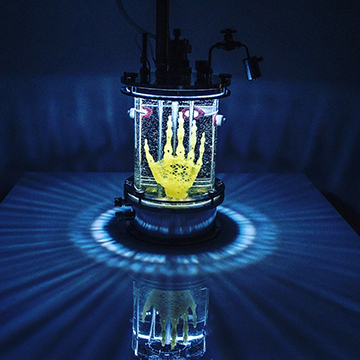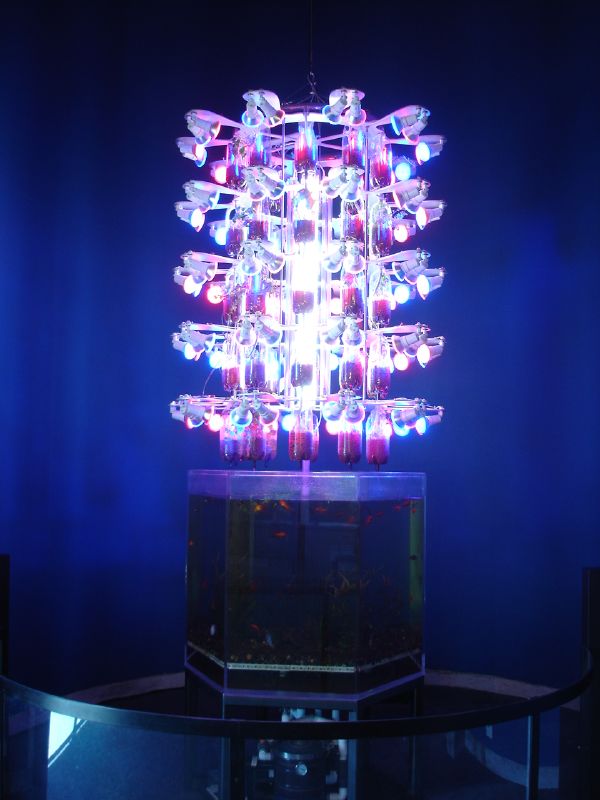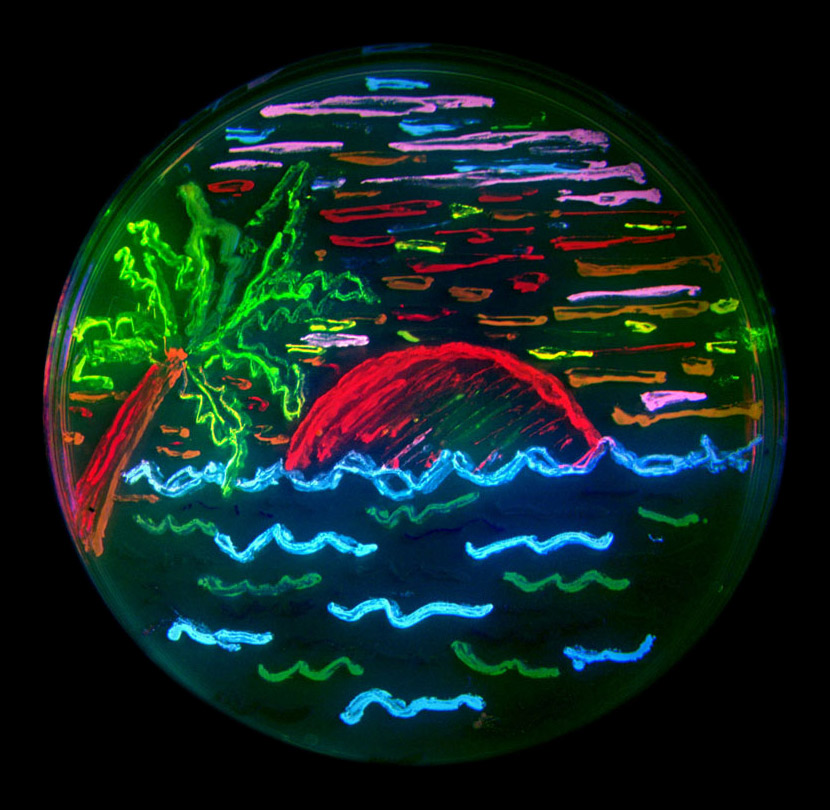|
Bioart
BioArt is an art practice where artists work with biology, live tissues, bacteria, living organisms, and life processes. Using scientific processes and practices such as biology and life science practices, microscopy, and biotechnology (including technologies such as genetic engineering, tissue culture, and cloning) the artworks are produced in laboratories, galleries, or artists' studios. The scope of BioArt is a range considered by some artists to be strictly limited to "living forms", while other artists include art that uses the imagery of contemporary medicine and biological research, or require that it address a controversy or blind spot posed by the very character of the life sciences. Bioart originated at the end of the 20th century and beginning of the 21st century. Although BioArtists work with living matter, there is some debate as to the stages at which matter can be considered to be alive or living. Creating living beings and practicing in the life sciences brings abo ... [...More Info...] [...Related Items...] OR: [Wikipedia] [Google] [Baidu] |
Amy Karle
Amy Karle (born 1980) is an American artist, bioartist and futurist. She creates work that looks forward to a future where technology can support and enhance the human condition. She was named in BBC's 100 women, as one of the 100 inspiring and influential women from around the world for 2019. Her work questions what it means to be human, with an emphasis on exploring the relationship between technology and humanity; particularly how technology and biotechnology impacts health, humanity, evolution and the future. She combines science and technology with art and is known for using live tissue in her works. Karle uses body based investigation and the actual science and technology as tools in the process of creating the artworks. Amy Karle's artworks include new media art, bioart, computational art, hybrid art, body art, durational performance art, installation art, and garments and wearable art. Karle is most noted for her artworks merging the body and technology, including ''Rege ... [...More Info...] [...Related Items...] OR: [Wikipedia] [Google] [Baidu] |
Suzanne Anker
Suzanne Anker (born August 6, 1946) is an American visual artist and theorist. Considered a pioneer in Bio Art., she has been working on the relationship of art and the biological sciences for more than twenty five years. Her practice investigates the ways in which nature is being altered in the 21st century. Concerned with genetics, climate change, species extinction and toxic degradation, her work calls attention to the beauty of life and the "necessity for enlightened thinking about nature’s 'tangled bank'.” Anker frequently assembles with "pre-defined and found materials" botanical specimens, medical museum artifacts, laboratory apparatus, microscopic images and geological specimens. Biography Life and education Suzanne Anker was born in Brooklyn, New York on August 6, 1946. She earned a B.A. in Art from Brooklyn College of the City of New York and an M.F.A. from the University of Colorado in Boulder (1976). She also completed independent Studies with Ad Reinhardt ... [...More Info...] [...Related Items...] OR: [Wikipedia] [Google] [Baidu] |
Ken Rinaldo
Kenneth E. Rinaldo (born 1958) is an American neo-conceptual artist and arts educator, known for his interactive robotics, 3D animation, and BioArt installations. His works include Autopoiesis (2000), and Augmented Fish Reality (2004), a fish-driven robot.Stocker, G., Schöpf, C. (2004). International Compendium: Prix Ars Electronica 2004 : CyberArts 2004. Austria: Hatje Cantz. Biography Rinaldo was born in Queens and raised in Long Island. He attended Ward Melville High School in East Setauket, New York. He moved to California and earned an Associate of Science degree in Computer Science from Cañada College, 1982. He went on to earn a Bachelor of Arts in Communications from The University of California, Santa Barbara; 1984 and a Master of Fine Arts in Conceptual Information Arts from San Francisco State University, 1996. At San Francisco State he studied with artists Steve Wilson, Brian Rogers, George LeGrady and Paul DeMarinis. In 2000 he received the first prize a ... [...More Info...] [...Related Items...] OR: [Wikipedia] [Google] [Baidu] |
Hybrid Art
Hybrid art is a contemporary art movement in which artists work with frontier areas of science and emerging technologies. Artists work with fields such as biology, robotics, physical sciences, experimental interface technologies (such as speech, gesture, face recognition), artificial intelligence, and information visualization. They address the research in many ways such as undertaking new research agendas, visualizing results in new ways, or critiquing the social implications of the research. The worldwide community has developed new kinds of art festivals, information sources, organizations, and university programs to explore these new arts. Overview/ history of the term Many artists are responding to the central role scientific and technological research plays in contemporary culture. They are going beyond merely using technological tools and gadgets (e.g. computers) in their work to engage deeply with the processes of research. They are creating revolutionary art at the fron ... [...More Info...] [...Related Items...] OR: [Wikipedia] [Google] [Baidu] |
Microbial Art
Microbial art, agar art, or germ art is artwork created by culturing microorganisms in certain patterns. The microbes used can be bacteria, yeast fungi, or less commonly, protists. The microbes can be chosen for their natural colours, or can be engineered to express fluorescent proteins and viewed under ultraviolet light to make them fluoresce in colour. Methods Agar plates are used as a canvas, while pigmented or fluorescent bacteria and yeasts represent the paint. In order to preserve a piece of microbial art after a sufficient incubation, the microbe culture is sealed with epoxy. Microbe species can be chosen for their natural colours to form a palette for the artwork. Suitable species of bacteria (with their colours) include ''Bacillus subtilis'' (cream to brown), ''Chromobacterium violaceum'' (violet), ''Escherichia coli'' (colourless), ''Micrococcus luteus'' (yellow), '' Micrococcus roseus'' (pink), ''Proteus mirabilis'', ''Pseudomonas aeruginosa'' (brown), ''Pseudomonas ... [...More Info...] [...Related Items...] OR: [Wikipedia] [Google] [Baidu] |
Microbial Art
Microbial art, agar art, or germ art is artwork created by culturing microorganisms in certain patterns. The microbes used can be bacteria, yeast fungi, or less commonly, protists. The microbes can be chosen for their natural colours, or can be engineered to express fluorescent proteins and viewed under ultraviolet light to make them fluoresce in colour. Methods Agar plates are used as a canvas, while pigmented or fluorescent bacteria and yeasts represent the paint. In order to preserve a piece of microbial art after a sufficient incubation, the microbe culture is sealed with epoxy. Microbe species can be chosen for their natural colours to form a palette for the artwork. Suitable species of bacteria (with their colours) include ''Bacillus subtilis'' (cream to brown), ''Chromobacterium violaceum'' (violet), ''Escherichia coli'' (colourless), ''Micrococcus luteus'' (yellow), '' Micrococcus roseus'' (pink), ''Proteus mirabilis'', ''Pseudomonas aeruginosa'' (brown), ''Pseudomonas ... [...More Info...] [...Related Items...] OR: [Wikipedia] [Google] [Baidu] |
Eduardo Kac
Eduardo Kac �dwardoʊ kæts; ĕd·wâr′·dō kăts(1962) is a contemporary artist of dual nationality (American and Brazilian) whose artworks span a wide range of practices, including performance art, poetry, holography, interactive art, digital and online art, and bio art. He is particularly well known for his works of space art. Kac began his art career in 1980 as a performance artist in Rio de Janeiro, Brazil. In 1982 he created his first digital work and in 1983 he invented holopoetry, exploring holography as an interactive art form. In 1985 he began creating animated poetic works on the French Minitel platform. Throughout the 1980s Kac created telecommunications artworks, using media such as fax, television, and slow scan tv. In 1986 Kac created his first work of telepresence art, in which he used robots to bridge two or more physical locations. During the 1990s he continued to produce these works, expanding his practice with works of interspecies communications. In 1997 h ... [...More Info...] [...Related Items...] OR: [Wikipedia] [Google] [Baidu] |
Stelarc
Stelarc (born Στέλιος Αρκαδίου ''Stelios Arcadiou'' in Limassol in 1946; legally changed his name in 1972) is a Cyprus-born Australian performance artist raised in the Melbourne suburb of Sunshine, whose works focus heavily on extending the capabilities of the human body. As such, most of his pieces are centered on his concept that "the human body is obsolete". Until 2007 he held the position of principal research fellow in the Performance Arts Digital Research Unit at Nottingham Trent University in Nottingham, England. He is currently furthering his research at Curtin University in Western Australia. Performances Stelarc's idiosyncratic performances often involve robotics or other relatively modern technology integrated with his body. In 26 different performances he has suspended himself in flesh hook suspension, often with one of his robotic inventions integrated. His last suspension performance was held in Melbourne in March 2012. In another performance ... [...More Info...] [...Related Items...] OR: [Wikipedia] [Google] [Baidu] |
Stelarc Extra Ear Ear On Arm
Stelarc (born Στέλιος Αρκαδίου ''Stelios Arcadiou'' in Limassol in 1946; legally changed his name in 1972) is a Cyprus-born Australian performance artist raised in the Melbourne suburb of Sunshine, whose works focus heavily on extending the capabilities of the human body. As such, most of his pieces are centered on his concept that "the human body is obsolete". Until 2007 he held the position of principal research fellow in the Performance Arts Digital Research Unit at Nottingham Trent University in Nottingham, England. He is currently furthering his research at Curtin University in Western Australia. Performances Stelarc's idiosyncratic performances often involve robotics or other relatively modern technology integrated with his body. In 26 different performances he has suspended himself in flesh hook suspension, often with one of his robotic inventions integrated. His last suspension performance was held in Melbourne in March 2012. In another performance he a ... [...More Info...] [...Related Items...] OR: [Wikipedia] [Google] [Baidu] |
University Of Western Australia
The University of Western Australia (UWA) is a public research university in the Australian state of Western Australia. The university's main campus is in Perth, the state capital, with a secondary campus in Albany, Western Australia, Albany and various other facilities elsewhere. UWA was established in 1911 by an act of the Parliament of Western Australia and began teaching students two years later. It is the sixth-oldest university in Australia and was Western Australia's only university until the establishment of Murdoch University in 1973. Because of its age and reputation, UWA is classed one of the "sandstone universities", an informal designation given to the oldest university in each state. The university also belongs to several more formal groupings, including the Group of Eight (Australian universities), Group of Eight and the Matariki Network of Universities. In recent years, UWA has generally been ranked either in the bottom half or just outside the University rankings ... [...More Info...] [...Related Items...] OR: [Wikipedia] [Google] [Baidu] |
Eduardo Kac - Genesis - Ars Electronica 99
Eduardo is the Spanish and Portuguese form of the male given name Edward. Another version is Duarte. It may refer to: Association football * Eduardo Bonvallet, Chilean football player and sports commentator * Eduardo Carvalho, Portuguese footballer * Eduardo "Edu" Coimbra, Brazilian footballer * Eduardo Costa, Brazilian footballer * Eduardo da Conceição Maciel, Brazilian footballer * Eduardo da Silva, Brazilian-born Croatian footballer * Eduardo Adelino da Silva, Brazilian footballer * Eduardo Ribeiro dos Santos, Brazilian footballer * Eduardo Gómez (footballer), Chilean footballer * Eduardo Gonçalves de Oliveira, Brazilian footballer * Eduardo Jesus, Brazilian footballer * Eduardo Martini, Brazilian footballer * Eduardo Ferreira Abdo Pacheco, Brazilian footballer Music * Eduardo (rapper), Carlos Eduardo Taddeo, Brazilian rapper * Eduardo De Crescenzo, Italian singer, songwriter and multi-instrumentalist Politicians * Eduardo Año, Filipino politician and retired army genera ... [...More Info...] [...Related Items...] OR: [Wikipedia] [Google] [Baidu] |
Organ Transplantation In Japan
Organ transplantation in Japan is regulated by the 1997 Organ Transplant Law which legalized organ procurement from "brain dead" donors. After an early involvement in organ transplantation that was on a par with developments in the rest of the world, attitudes in Japan altered after a transplant by Dr. Wada in 1968 failed, and a subsequent ban on cadaveric organ donation lasted 30 years. The first transplant after the Organ Transplant Law had defined "brain death" took place in February 1999. Due to cultural reasons and a relative distrust of modern medicine, the rate of organ donation in Japan is significantly lower than in Western countries. History The first organ transplant in Japan took place at Niigata University in 1956 when a kidney was temporarily transplanted to a patient with acute renal failure. In 1964 a permanent and full-scale kidney transplant was successfully undertaken at the University of Tokyo, and by 1992 nearly 9,000 kidney transplants had taken place. In the ... [...More Info...] [...Related Items...] OR: [Wikipedia] [Google] [Baidu] |


_by_Suzanne_Anker.jpg)



.jpg)
